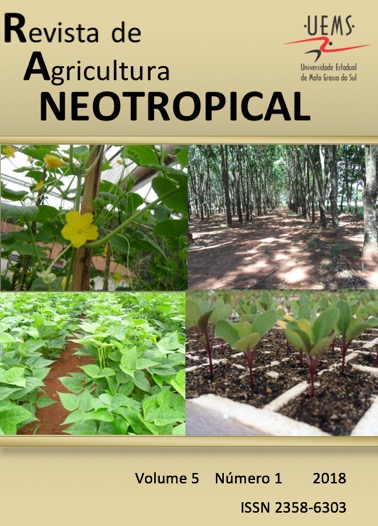THERMAL VARIATION FOR GROWTH OF ZOOSPORES OF Albugo spp.
DOI:
https://doi.org/10.32404/rean.v5i1.1634Resumo
The objective of this work was to identify the time of the thermal shock that promotes the greater release of zoospores/sporangia. The experiments were carried out with five treatments, varying the thermal variation time (20', 30', 40', 50' and 60') of sporangia suspension of 7.105 sporangia mL-1 under 5 °C temperature. The incidence of sporangia germinated by 20 times whose It was evaluated100 units at random, using an optical microscope at 40 times magnification. The F and Tukey test were used to compare the means. The sexual phase (presence of oospores) was identified in the isolate derived from purslane. In purslane leaves (infected by Albugo portulacae) the time of 20-30' promoted a greater number of zoospores released, whereas for the isolate from amarantus (infected by A. bliti) the time of 30’ promoted statistically the highest release of zoospores; for the isolate from leaves of “jetirana” (infected by A. ipomoeae-panduratae) the time of 30-50’ promoted greater release of zoospores; and finally the isolate from “onze-horas” leaves (infected by A. portulacae) the time of 30-40’ statistically promoted the highest percentage of release of zoospores, It was demonstrating a differential behavior per host in the release of zoospores. The thermal shock time that promoted the highest amount of released zoospores (38 %) was observed for the purslane-Albugo portulacae and “onze horas”-A. portulacae pathosystem.Referências
(I) AGRIOS, G. N. Plant Pathology. 4. ed., Burlington: Elsevier, Academic Press. 1997. 606 p.
(II) ALEXOPOULOS, C. J.; MIMS, C. W.; BLACKWELL, M. Introductory Mycology. New York-USA: John Wiley & Sons, Inc., 1996. 865 p.
BERGAMIN FILHO, A.; AMORIM, L. Epidemiologia de doenças de plantas. In: Amorim, L., Rezende, J. A. M., Bergamin Filho, A. (Eds.). Manual de Fitopatologia: Princípios e conceitos. 4 ed. São Paulo-SP: Ceres, 2011, v. 1, p. 101-118.
(III) BORHAN, H. M.; BROSE, E.; BEYNON, J. L.; HOLUB, E. B. White rust (Albugo candida) resistance loci on three Arabidopsis chromosomes are closely linked to downy mildew (Peronospora parasitica) resistance loci. Molecular Plant Pathology, London-UK, v. 2, n. 2, p. 87-95, 2001.
(IV) FARR, D. F.; ROSSMAN, A. Y. Fungal Databases, Systematic Mycology and Microbiology Laboratory, Ars, USDA. Washington, DC, USA: Available at: [http://nt.ars-grin.gov/fungaldatabases/], Accessed nov. 2018.
(V) HOLUB, E. B.; BROSE, E.; TOR, M.; CLAY, C.; CRUTE, I. R.; BEYNON, J. L. Phenotypic and genotypic variation in the interaction between Arabidopsis thaliana and Albugo candida. Molecular Plant-Microbe Interactions, Virginia-USA, v. 8, n. 5, p. 916-928. 1995.
(VI) KIMATI, H.; AMORIM, L.; BERGAMIM FILHO, A.; CAMARGO, L. E. A.; REZENDE, J. A. M. Manual de Fitopatologia. 3. ed. São Paulo-SP: Agronômica Ceres. 1995. 919 p.
(VII) PAGANI, A. P. S.; DIANESE, A. C.; INACIO, C. A.; CAFE FILHO, A. S. Occurrence of white rust (Albugo ipomoeae-panduratae) on Ipomoea acuminata in the Brazilian mid-west. Brazilian Journal of Microbiology, São Paulo, SP, v. 43, n. 1, p. 306-308, 2012.
(VIII) PETRIE, G. A. Prevalence of oospores of Albugo cruciferarum in brassica seed samples from Western Canada 1967-1973. Canadian Plant Disease, Montreal, Canadá, v. 55, n. 1, p. 19- 24, 1975.
(IX) LOCH, S.; CHOI, Y. J.; ROST, C.; SHIN, H. D.; SCHILLING, E.; THINES, M. Evolution of diversity in Albugo is driven by high host specificity and multiple speciation events on closely related Brassicaceae. Molecular Phylogenetics and Evolution, Illinois-USA, v. 57, n. 2, p. 812-820. 2010.
Downloads
Publicado
Como Citar
Edição
Seção
Licença
Os autores mantêm os direitos dos artigos e, portanto, são livres para compartilhar, copiar, distribuir, executar e comunicar publicamente o trabalho sob as seguintes condições:
Reconheça os créditos do trabalho da maneira especificada pelo autor ou licenciante (mas não de uma maneira que sugira que você tenha o apoio deles ou que eles apoiem o uso do trabalho deles).
JOURNAL OF NEOTROPICAL AGRICULTURE - Revista de Agricultura Neotropical (ISSN 2358-6303) está sob licença https://creativecommons.org/licenses/by/4.0/
A Universidade Estadual de Mato Grosso do Sul, Centro de Desenvolvimento Sustentável do Bolsão Sul-Mato-grossense (CEDESU), da Unidade Universitária de Cassilândia (UUC) conserva os direitos patrimoniais (direitos autorais) das obras publicadas e favorece e permite a sua reutilização sob a licença supracitada.
------------
A revista se reserva o direito de efetuar, nos originais, alterações de ordem normativa, ortográfica e gramatical, com vistas a manter o padrão culto da língua, respeitando, porém, o estilo dos autores.
A provas finais serão enviadas aos autores.
Os trabalhos publicados passam a ser propriedade da revista. As opiniões emitidas pelos autores dos artigos são de sua exclusiva responsabilidade.


